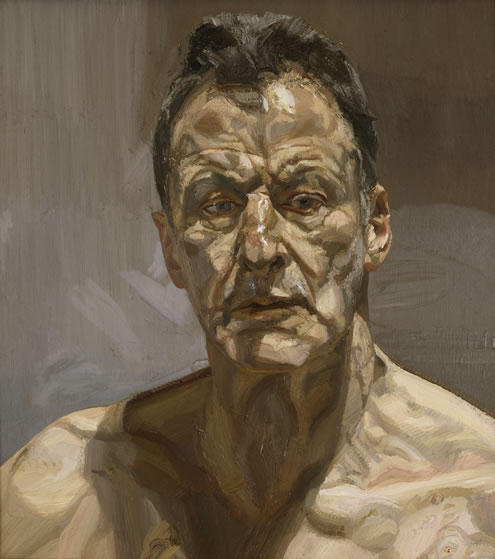
Working digitally often takes us very far from traditional approaches and about a year ago I found that for me the results were no longer that satisfactory and I felt the need of going back to the roots while at the same time not disregarding the digital medium as such.
I didn’t deliberately decide to choose specific artists as mentors of sorts, it just happened that I found myself looking more and more at the work of three of them.
The three became my guidance as I approached brushstroke, color and form all over again.
I’ll make a brief presentation of these three artists in three posts, to explain but also understand why I took them as guidance, but also to share the beauty of their work.
Paul Cezanne, Jan Mankes, Lucian Freud
Discovering Lucian Freud‘s work can make quite an impact.
I admit it’s not easy to present this artist, because I’d like to post many of the nudes he painted later in his life and constituting the largest body of work, but most might cringe at the sight of them.
I’ll let you discover them by yourself while showing you some of the most approachable ones he has made.
Lucian was Sigmund Freud’s nephew, but he lived and painted in England. He died in 2011 and he’s considered one of the major British modern painters.
 Here I’ll be focusing on his latest pieces.
Here I’ll be focusing on his latest pieces.
His work changed quite a bit since the 50s. The way he worked the human figure became more realistic and detailed.
And yet there’s something slightly caricaturesque in these large paintings that impose oversized human bodies onto the viewer with a bluntness that I’ve never seen before.
It’s not unlikely to feel repulsed by a raw nudity that seems to reveal much more than just a bare body.
Red knuckles, blue veins, livid spots, fat and bones are exacerbated and jump to the viewer with uncomfortable honesty.
We might even shy away from such exposure, as if the nude body in the painting were our own.
It’s then that I noticed the similarity between Lucian and his grandfather Sigmund: both of them adopted an inquisitive eye to discover the inner workings of the individual. The nudity of the psyche is projected onto the anatomical surface of the individual.
He lets us discover the models’ personality and sexuality through the various imperfections of the aged flesh.
Not even Kate Moss is spared: the artist strips her down of all the aura of the runway and shows us an imperfect woman. Unveiled truth. Body of the Real.
 Moreover sex is evidently central in Lucian’s work as it was in Sigmund’s. He paints genital areas with great precision and yet devoid of any eroticism.
Moreover sex is evidently central in Lucian’s work as it was in Sigmund’s. He paints genital areas with great precision and yet devoid of any eroticism.
Lucian studies these men and women like a scientist with an x-ray pupil into the psyche. Even the way most models lay down on the bed or sofas like corpses to be examined or psychoanalysed can be unsettling to the viewer.
Eros and Thanatos go hand in hand in his work.
All the above is accomplished thanks to an impressive technique, especially the use of various colors and tones for the skin. It’s a painting lesson in itself. While he’s certainly not the only artist approaching flesh tone this way, his brushwork together with the subjects make it all the more striking.
 I probably wouldn’t hang most of Lucian Freud paintings on my walls even if I could. I wonder who would? They are huge and generally unsettling. Even looking at them seems indiscreet, like spying someone through a key hole.
I probably wouldn’t hang most of Lucian Freud paintings on my walls even if I could. I wonder who would? They are huge and generally unsettling. Even looking at them seems indiscreet, like spying someone through a key hole.
They are also so intimately connected to the models and their relationship with the artist that I can’t imagine them outside a gallery or Freud’s studio.
And yet, they are so powerful and masterfully done that we can simply admire their expressiveness and learn much from Freud’s technique while also taking his honest approach as an example.
The encounter with Lucian Freud’s art is a blow to the stomach and there’s no recovery from it. But it’s a fortune as well. It means that something has been redefined in the art of portrait making.
There’s always the need for artists who are able to pull a punch, because they might save us from the dangerous comforts of politically-corrected pop-corn “art”.
It seems appropriate to conclude this little journey with an acknowledgement to the artist who started it, Paul Cezanne. Lucian Freud’s made a painting entitled “After Cezanne”, a reinterpretation of “Afternoon in Naples”. It’s an important statement that I was glad to discover, because in our times without Fathers it’s vital to keep an eye to the legacy of that which is most valuable to us. We never travel alone.

Additional resources: vast selection of Lucian Freud‘s work and info at Artsy.net

